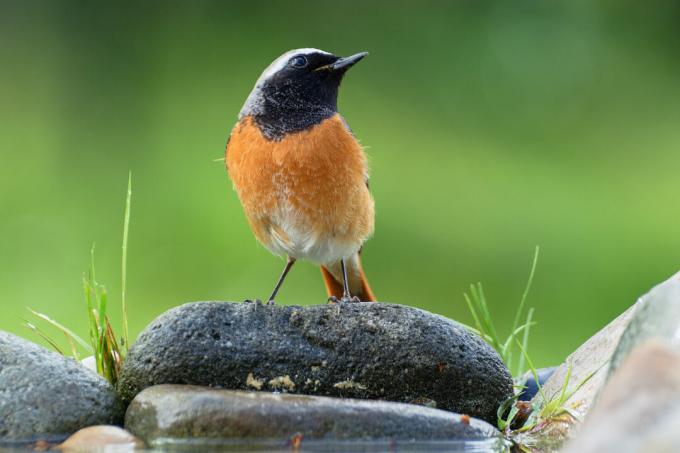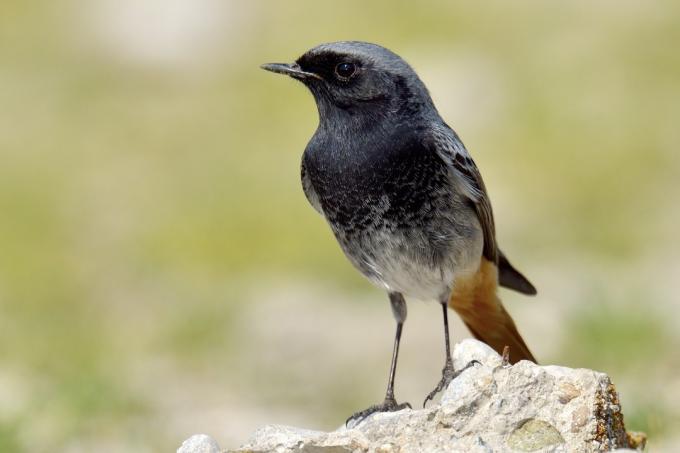What do redstart females look like? How do the common redstart and the black redstart differ from each other? In our profile you will find out everything you need to know about food, nests, young birds and more.

Even if the name Redstart (Phoenicurus phoenicurus) suggests a much-seen guest in home gardens, the species is much less common than the closely related one Black redstart(Phoenicurus ochruros). In the last few decades in particular, the redstart population has decreased significantly because of its preferred ones Habitats, such as light forests and orchards, are increasingly lost in our intensively used landscape walk. In order to draw attention to this grievance, the redstart was voted “Bird of the Year” in 2011. Anyone who discovers the species in their garden today can consider themselves lucky and will also be rewarded with a breathtaking sight. Because the common redstart impresses with its high-contrast and colorful plumage. How to clearly recognize the rare redstart, how to distinguish it from the black redstart and much more, you can find out here.
contents
- Redstart: profile
-
This is how you recognize the common redstart
- What is the difference between redstart females and males?
- How does the common redstart singing sound?
- How do you recognize young redstart birds?
- How do you recognize redstart eggs?
- What is the difference between the common redstart and the black redstart?
- Which habitat does the common redstart prefer?
- Where does the redstart build its nest?
- When do redstart breed?
- Where is the redstart in winter?
-
Support the common redstart: this is how it works
- What do redstart eat?
- Which nest boxes are suitable for the common redstart?
- How can you additionally support the common redstart?
Redstart: profile
| size | About 13-14 cm |
| weight | About 15 g |
| Breeding season | May - July |
| lifespan | About 5 years |
| habitat | Orchards, light forests, parks and gardens |
| Feed preference | Insects, spiders, berries |
| Threats | Loss of habitat and food sources |
This is how you recognize the common redstart
A male redstart is a magnificent and unique sight. The small songbirds have a dark gray back and the same colored wing covers. They also wear a gray cap, which is separated by a white headband from a jet black face, and a radiant rust-red underside, the color of which extends to the lower end of the tail.

What is the difference between redstart females and males?
Female redstart specimens are much more plainly colored. The gray-brown upper side is only a slight contrast to the slightly lighter underside. The breast of the females is slightly orange-red in color, but the color intensity can vary between individuals and is only faintly or not at all visible in some. The only clear splash of color is the bright rust-red colored underside of the tail, which, however, often only becomes visible when it flies up.

How does the common redstart singing sound?
The redstart's song sounds a bit wistful and consists of a sequence of very clear whistling tones. Even if the exact structure can vary somewhat, the singing usually starts with a single high note, then turns into an easy one falling stanza of whistling tones over and ending with differently designed closing tones: "Sii-tü-tü-tü-tü-tü-tü-jik-jik-jik".
You can listen to the redstart singing here:

How do you recognize young redstart birds?
The young birds of the common redstart can already be clearly assigned by the red underside of the tail. The rest of the plumage colors are more reminiscent of the inconspicuous appearance of the females, from which the young differ, however, by a large number of fine speckles. The spots disappear over the first winter, but the young birds do not shine in their adult plumage until the next spring.

How do you recognize redstart eggs?
Redstart eggs are an intense green-blue color and have no patterns. The eggs are placed in a nest hollow that has been carefully padded with moss, hair and feathers. A female lays between six and seven eggs per clutch.

What is the difference between the common redstart and the black redstart?
Garden and Black redstart share the shape and the bright rust-red underside of the tail. In contrast to the common redstart, the black redstart males do not have a red breast. Her back, as well as her head and burst, are all dark, and her face and chest are even deep black. Instead, a white wing field emerges on the dark wing-coverts of the male black redstart.

Since female redstart and redstart are each much more plainly colored, they are also more difficult to distinguish. Black redstartHowever, females have a darker plumage in comparison, while redstart females have a lighter, slightly red-colored breast.

Which habitat does the common redstart prefer?
As cave breeders, redstart relies on old trees with knotholes and other tree hollows in a natural habitat. Therefore, they prefer light forests and forest edges. But landscapes that are a little more shaped by humans are gladly accepted, such as orchards, parks and wild gardens.
Where does the redstart build its nest?
The common redstart builds its nest in a cave or semi-cave. Natural tree hollows, building and wall niches or nesting boxes are used for this. The male presents the female with several nesting options in his territory, but the final decision and the design of the home is made by the female herself. The entire width of the cave is covered with nesting material in the form of stalks, leaves, sticks, or moss Made of lichen and the small recess for the eggs with a lot of soft material such as hair or feathers padded.

When do redstart breed?
Redstart breed between May and July. During this time only one brood is raised, rarely two broods. After all the eggs have been laid, they are incubated for about two weeks. After that, the young birds are fed in the nest for another 14 days before they are big enough to explore the area. However, by the end of August at the latest, all of the young animals have flown out and have to start their first long journey.
Where is the redstart in winter?
The common redstart belongs to the long-distance migrants. The animals spend the winter south of the Sahara. They won't come back to us until the end of March to the beginning of April. The males arrive a little earlier and occupy their territories so that they have something to offer the females when they arrive.
Support the common redstart: this is how it works
Due to the increasing intensification of our agriculture and the ongoing death of insects, the common redstart is slowly but surely depriving the redstart of nesting and food sources. In the following sections you will find out how you can give this colorful bird a home in your own garden.
What do redstart eat?
Redstart are passionate about insectivores. The animals are often searched for on the ground or in the lower layer of the bush. But also spiders, harvestmen and other small animals such as millipedes or woodlice, as well as berries and fruits, are eaten. Since the redstart spend the winter in Africa, classic winter feeding is not possible. Redstart is most happy about the abundance of insects in summer.
Which nest boxes are suitable for the common redstart?
As cave and half-cave breeders, redstart can be very well supported with a nest box in the garden. How you can easily get oneBuild your own nest box You can find out which materials are suitable for this and where you can best attach the finished nesting aid in our special article. Redstart prefer one or two oval entry holes when fully closed, which should be 30 millimeters wide and 45 millimeters high. But half-cave boxes with a half-open front are also gladly accepted.

How can you additionally support the common redstart?
A nesting box in the garden is certainly inviting, but in order to persuade a redstart to move in, the food supply must of course also be right. Create a bird and insect friendly garden with a row more insect-friendly flowersthat you can apply individually or as a seed mixture. You can create such a flower meadow quickly and easily with ours, for example Plantura beneficial insect magnet. With this seed mix you can easily create a true paradise of beneficial insects that not only garden birds but also your plants will be happy about.
Of course, many other bird species are also happy about such a food supply. If you want to find out more about the feathered garden visitors, then take a look at our other species portraits Common Swift, Girlitz and Co. over.
